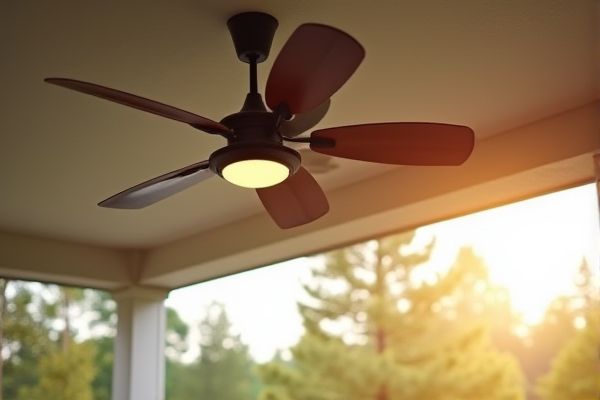
Outdoor ceiling fans provide a consistent breeze to cool your space by circulating air, while misting fans combine airflow with fine water mist to reduce temperature more effectively in hot environments. Discover which option best suits your needs to enhance Your outdoor comfort by reading the rest of the article.
Table of Comparison
| Feature | Outdoor Ceiling Fan | Misting Fan |
|---|---|---|
| Primary Function | Circulates air to create a cooling breeze | Combines airflow with water mist for enhanced cooling |
| Cooling Method | Air movement only | Air movement plus evaporative cooling via water mist |
| Installation | Ceiling mounted, fixed installation | Portable or mounted options available |
| Best Use | Shaded outdoor areas like patios and porches | Open outdoor spaces in hot, dry climates |
| Water Requirement | None | Requires water connection or reservoir |
| Power Source | Electricity, hardwired | Electricity, plug-in or battery |
| Maintenance | Low; occasional blade cleaning | Higher; water system cleaning, filter changes |
| Humidity Impact | No increase in humidity | Increases local humidity through mist |
| Typical Price Range | $150 to $600 | $100 to $400 |
Introduction to Outdoor Cooling Solutions
Outdoor cooling solutions include outdoor ceiling fans and misting fans, both designed to enhance comfort in open-air environments. Outdoor ceiling fans circulate air to create a breeze and reduce perceived temperature, while misting fans combine airflow with fine water mist to lower ambient temperature through evaporative cooling. Selecting the right option depends on factors such as climate, humidity, and desired cooling intensity for patios, decks, or garden spaces.
What Is an Outdoor Ceiling Fan?
An outdoor ceiling fan is a durable fan designed to be mounted on ceilings in open or semi-enclosed outdoor spaces, made with weather-resistant materials such as stainless steel and sealed motor components to withstand moisture, humidity, and temperature fluctuations. These fans enhance outdoor comfort by circulating air to reduce heat and humidity, making patios and porches more enjoyable during warm weather. Unlike misting fans, outdoor ceiling fans do not disperse water, focusing solely on air movement for cooling purposes.
What Is a Misting Fan?
A misting fan combines the cooling effect of high-speed airflow with a fine water mist that rapidly lowers the surrounding temperature, making it ideal for outdoor use in hot climates. Unlike a traditional outdoor ceiling fan that circulates air without moisture, a misting fan actively reduces heat through evaporation, providing a refreshing experience during intense heat. Your choice between the two depends on whether you prioritize dry air circulation or enhanced cooling through mist.
Key Differences Between Outdoor Ceiling Fans and Misting Fans
Outdoor ceiling fans circulate air to create a cooling breeze without adding moisture, making them ideal for dry or moderately humid climates. Misting fans combine airflow with a fine water mist, effectively lowering the temperature through evaporative cooling, suited for hot and dry environments. Your choice depends on whether you prioritize air circulation alone or require enhanced cooling via moisture.
Cooling Efficiency Comparison
Outdoor ceiling fans provide consistent air circulation that helps evaporate sweat and reduce perceived temperature by up to 4 degrees Fahrenheit, making them highly energy-efficient for cooling open spaces. Misting fans combine air movement with fine water mist, cooling the air temperature by up to 15 degrees Fahrenheit through evaporative cooling, which is highly effective in dry, hot climates. Cooling efficiency depends on environmental factors: outdoor ceiling fans excel in humid or shaded areas, while misting fans perform better in arid conditions with high heat and low humidity.
Energy Consumption and Cost Analysis
Outdoor ceiling fans typically consume between 45 to 75 watts per hour, offering energy-efficient cooling suitable for extended use, while misting fans can use 150 to 250 watts or more due to their water pump and misting system. The initial cost of outdoor ceiling fans ranges from $100 to $300, with lower ongoing energy expenses, whereas misting fans often have higher upfront prices and increased operational costs due to water usage and maintenance. Your choice should consider long-term energy consumption and cost, especially if you plan to run the fan frequently in hot outdoor environments.
Installation and Maintenance Requirements
Outdoor ceiling fans typically require professional installation involving secure mounting to a ceiling structure and electrical wiring, while misting fans offer more flexibility with plug-and-play setups and occasional refilling of water reservoirs. Maintenance for outdoor ceiling fans includes periodic cleaning of blades and motor lubrication, whereas misting fans demand regular cleaning to prevent clogging of nozzles and ensuring water quality to avoid buildup. Your choice depends on convenience and the level of upkeep you are prepared to manage.
Suitability for Different Outdoor Spaces
Outdoor ceiling fans are ideal for covered patios, porches, and gazebos, providing consistent airflow while protecting the motor from rain and debris. Misting fans suit open-air areas like gardens, poolside, or large terraces, offering both cooling air and fine water mist to lower temperatures effectively. Your choice depends on the outdoor space's layout and exposure to elements, ensuring optimal comfort and functionality.
Pros and Cons of Outdoor Ceiling Fans
Outdoor ceiling fans provide consistent air circulation ideal for covered patios, reducing heat and deterring insects without increasing humidity. They operate quietly and use less energy than misting fans but lack the cooling effect of water evaporation. Installation requires a sturdy overhead structure and professional wiring, limiting their use in open or uncovered outdoor spaces.
Pros and Cons of Misting Fans
Misting fans provide excellent cooling by combining airflow with fine water mist, making them ideal for hot, dry climates and outdoor spaces. They offer rapid temperature reduction and increased comfort but require a water source and regular maintenance to prevent clogging and mold buildup. Your choice depends on the balance between enhanced cooling performance and the added upkeep compared to a standard outdoor ceiling fan.
 homyna.com
homyna.com